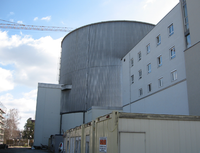
Forschungsreaktor 2 (FR2)
Encyclopedia

Germany
Germany , officially the Federal Republic of Germany , is a federal parliamentary republic in Europe. The country consists of 16 states while the capital and largest city is Berlin. Germany covers an area of 357,021 km2 and has a largely temperate seasonal climate...
after restrictions on nuclear research imposed as a result of the Second World War were lifted in 1955. Construction began in 1957 in Eggenstein-Leopoldshafen
Eggenstein-Leopoldshafen
Eggenstein-Leopoldshafen/BW is a town of about 15000 inhabitants located in the federal state of Baden-Württemberg in the Federal Republic of Germany. It lies about 12 km north of Karlsruhe and is the site of the northern campus of a research centre Karlsruhe Institute of Technology...
/BW
Baden-Württemberg
Baden-Württemberg is one of the 16 states of Germany. Baden-Württemberg is in the southwestern part of the country to the east of the Upper Rhine, and is the third largest in both area and population of Germany's sixteen states, with an area of and 10.7 million inhabitants...
. The organization charged with the project evolved into the Kernforschungszentrum Karlsruhe (KfK) (Karlsruhe Nuclear Research Centre), which in turn evolved into the present day Karlsruhe Institute of Technology
Karlsruhe Institute of Technology
The Karlsruhe Institute of Technology is a German academic research and education institution with university status resulting from a merger of the university and the research center of the city of Karlsruhe. The university, also known as Fridericiana, was founded in 1825...
(KIT).
FR2 started up on December 12, 1962, and ceased operation in December 1981. Today (2005), the reactor core is contained, and the auxiliary buildings have been demolished or are being used for non-nuclear research activities, mostly in micro process engineering
Micro process engineering
Micro process engineering is the science of conducting chemical orphysical processes inside small volumina,typically inside channels with diameters of less than 1 mm or other structures with sub-millimeter dimensions....
, which uses manufacturing technologies that originated from mechanical microstructuring processes that had been developed in the context of nuclear technologies (isotope separation
Isotope separation
Isotope separation is the process of concentrating specific isotopes of a chemical element by removing other isotopes, for example separating natural uranium into enriched uranium and depleted uranium. This is a crucial process in the manufacture of uranium fuel for nuclear power stations, and is...
).

